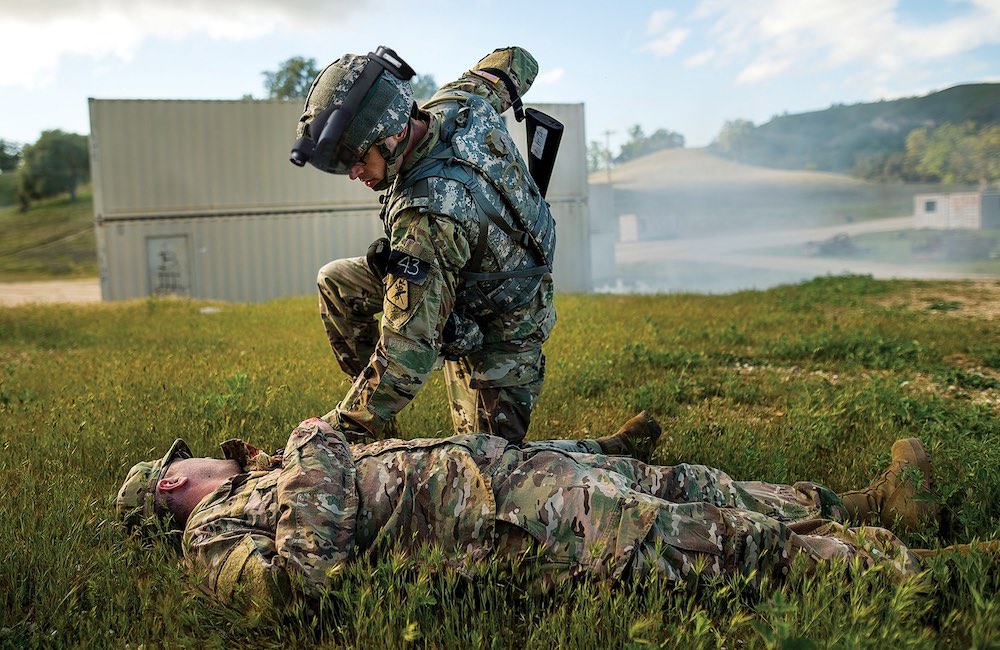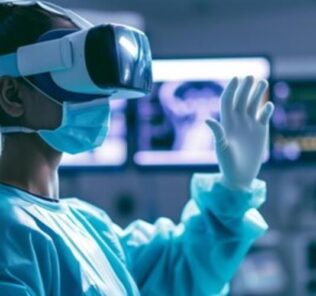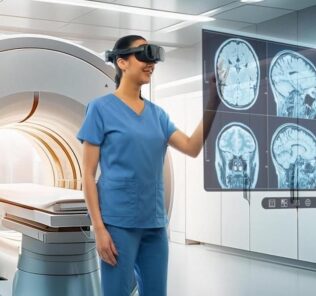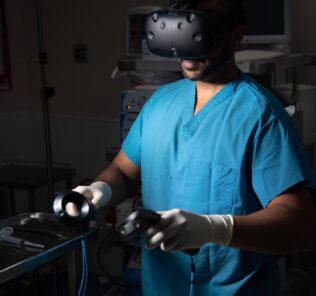Vcom3D Healthcare Simulation Technologies Fill Gaps in Medical Learning
The ability to immerse learners in healthcare simulation scenarios has proven to dramatically improve their overall understanding of medical practices, protocols, and procedures. As part of one company’s mission to develop innovative technology and products that aid learning and improve performance, Vcom3D provides immersive medical simulation and training systems. The company has been a leader in research, development, assessment, and transition of learning systems and technologies for the U.S. Military since 200, and continues to expand a research and development portfolio.
The Orlando-based, woman-owned small business, bases systems on plug-and-play architectures with interoperable physical and virtual patient and treatment modules. Vcom3D further provides innovative distributed learning systems, immersive virtual simulations, augmented reality (AR) based solutions, as well as virtual patients, medical manikins, and part-task trainers in blended reality learning solutions to train patient management. The systems are modular in design with open architectures and standards.
While focusing on filling medical training gaps, including trauma intervention, and distributed multi-site training, the company’s primary goal remains interoperability with other medical training systems. Vcom3D’s immersive systems ultimately provide training environments for medical teams to improve decision-making skills and team performance.
Sponsored Content:
All of Vcom3D’s authentic content is developed using research-based behavioral and physiological models, engages the learner in immersive gameplay, and assesses performance in realistic simulations. The Open Architectures and Interoperability design approach enables the inclusion of simulated injuries and response to treatment with other training systems such as the Army’s Synthetic Training Environment (STE) and Air Evacuation. Learning experiences are then delivered on tablets, personal computers, virtual or augmented reality displays, and instrumented physical models. Here is a run-down of Vcom3D’s technology offerings:
Architectures: Vcom3D’s medical simulation architecture supports a range of training applications, from modular manikins to virtual instruction, simulated patients, part-task trainers, networking, command and control, and learner assessment.
Medical manikins and Part-task Trainers, Medical Device Instrumentation: Vcom3D develops for multiple medical simulation modalities to tailor training based on the user’s needs and level of proficiency.
Blended Reality: Vcom3D develops Blended Reality Medical Trainers (BRMTs), which combine instrumented part-task trainers that communicate with virtual instruction tablets, providing realistic hands-on experiences for students, guiding, and assessing their performance, while reducing the workload of instructors.
Sponsored Content:
Distributed Learning Platform: The distributed learning platform enables remote learners to collaborate as teams on the IMPACTT medical training product.
MoHSES (AMM): Vcom3D is the lead software developer of the MoHSES architecture, an open standard specification for a human medical simulation platform with exchangeable and interoperable physical and virtual modules. Vcom3D has developed several modules that complement the Modular Healthcare Simulation and Education System (MoHSES™), formerly known as Advanced Modular Manikin™ (AMM). These modules are delivered on Android Tablets that communicate via Wi-Fi with a MoHSES-compliant CORE. The company has also developed Instructor and Assessment tablets that can be tailored to each application.
Virtual Medical Simulations: Vcom3D has adapted the award-winning 3D avatars, along with realistic simulated medical equipment, for use in a range of medical simulations, from point-of-injury trauma treatment to critical care environments. The virtual patients provide high-fidelity visual cues for injury presentation, emotional behavior, and physiological response.
Learner Assessment: As part of Vcom3D’s open architecture, the company is developing an assessment module to integrate with Learning/Content/Competency Management Systems, providing a path for live or asynchronous communication with a remote instructor or with a medical SME providing telemedical communication.
Augmented Reality (AR): Vcom3D is researching the integration of augmented reality technologies to enhance medical simulation scenarios by providing a more realistic experience for learners.
STE Medical – Synthetic Training Environment Medical: Vcom3D ‘s Network-enabled Combat Casualty Care (NETC3) is a system to train collective and critical thinking skills in complex tactical environments and to improve the decision-making abilities of soldiers treating life-threatening injuries on the battlefield. The objectives of this system will be pursued while incorporating Extended Reality technologies to augment current TCCC training with a view towards integrating with the Army IVAS head-mounted display and the STE training environment.
Live / Virtual/ Constructive / Gaming: Vcom3D is developing applications to simulate, track, and assess medical treatment across all LVCG environments.
Extended Reality – (VR/AR/MR): Vcom3D develops Extended Reality Medical Trainers consisting of HoloLens head-mounted displays, real-time virtual reality, and live environments.
IMPACTT Product Line
Vcom3D launched the company’s Immersive Modular Patient Care Team Trainer (IMPACTT) to fill additional gaps in team training by improving communication and collaborative decision making. IMPACTT On-site, IMPACTT Remote, and IMPACTT Anywhere Team Trainers enable learners to train in-person and/or join training sessions from remote locations using their own PC. IMPACTT also includes an innovative Instructor and Assessment tablet that automatically tracks learner performance.
Ultimately, IMPACTT delivers high-fidelity, virtual simulations for medical teams performing in environments ranging from Point of Injury to Air Evacuation and Hospital Care. Using IMPACTT’s Virtual Patient and Virtual Equipment, teams are trained and assessed in critical decision making, communication, and team dynamics. IMPACTT training uses low-cost, primarily COTS equipment and can be delivered at the point of demand.
Additionally, IMPACT includes a wireless access point so that all learner modules can be networked together, without adding requirements to the training facility infrastructure. Twelve or more wired or wireless modules are easily accommodated, and all can operate from rechargeable batteries. IMPACTT complies with all MoHSES (Modular Healthcare Simulation and Education System, formerly Advanced Modular Manikin, or AMM) data interoperability standards. This enables the trainer to integrate seamlessly with Vcom3D and third-party manikins, part-task trainers, and augmented reality / virtual reality (AR/VR) systems that conform to, or have been adapted to, the MoHSES data standards. Below are two videos exemplifying the benefits and possibilities extended by IMPACTT.
More About Vcom3D
Vcom3D has developed a Network Enabled Trainer for Combat Casualty Care, NETC3, to train and assess critical decision-making. This system leverages Extended Reality (XR) to augment live training. Further, the company’s research contract, STEM3T (Synthetic Training Environment for Multi-modal Medical Training) is a Multi-modal, Multi-Role, Multi-services medical training system with live, virtual, and manikin-based components. The system includes Authoring Tools and a Learning Record Store (LRS) as well.
In addition to the company’s independent solutions, Vcom3D helps provide funded research, such as medical simulation and training research, solutions, and products to premier healthcare organizations in the US government, state government, and educational sectors. These organizations lead the nation in closing training gaps and improving patient outcomes. Today, Vcom3D licenses medical simulation components to developers and proves technical services for customization and integration with third-party medical simulation systems.
Learn More About Vcom3D
Lance Baily, BA, EMT-B, is the Founder & CEO of HealthySimulation.com, which he started while serving as the Director of the Nevada System of Higher Education’s Clinical Simulation Center of Las Vegas back in 2010. Lance is also the Founder and acting Advisor to the Board of SimGHOSTS.org, the world’s only non-profit organization dedicated to supporting professionals operating healthcare simulation technologies. His co-edited Book: “Comprehensive Healthcare Simulation: Operations, Technology, and Innovative Practice” is cited as a key source for professional certification in the industry. Lance’s background also includes serving as a Simulation Technology Specialist for the LA Community College District, EMS fire fighting, Hollywood movie production, rescue diving, and global travel. He and his wife Abigail Baily, PhD live in Las Vegas, Nevada with their two amazing daughters.
Sponsored Content:




















